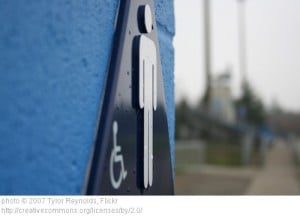Last week, writing for Everyday Feminism, Erin Tatum offered a terrific list of 10 Ways to Avoid Everyday Ableism. My favorite item is #9: Stop Calling Us Inspirational (which implies that the lives of people with disabilities must be so horrible that the mere fact that we get out of bed in the morning is laudable).
But a group of friends, all of whom have significant experience with living with disabilities that affect us or those we love, had some disagreement about #2: Don’t Use Handicapped Restrooms. I don’t agree with this one. Here’s why:
On the surface, never using a handicapped restroom stall if you are able-bodied seems akin to never using a handicapped parking spot without a permit. As I’ve written before, the reasons that able-bodied folk offer for using a handicapped parking space without a permit (“I’m only going to be a few minutes,” or “I sprained my ankle”) don’t hold up logically when one considers the purpose of handicapped spaces, the laws governing their use, and the reasonable expectations that those with legitimate handicapped parking permits have. But I’m not convinced that the same faulty logic applies to able-bodied people using a handicapped restroom stall, for one major reason:
 Everyone who uses a public restroom has a reasonable expectation that they may need to wait for a stall. This is an annoying but commonplace fact of life, especially for women. When you use a public restroom, chances are you’ll have to wait for a short (or not so short) time. If a person who uses a wheelchair or walker and thus needs the extra space and amenities of a handicapped restroom stall finds that stall occupied, he/she will have to wait. But unlike with a parking space, the person occupying the stall will likely vacate it in a few minutes. People with mobility impairments have a right to have accessible bathroom facilities in all public venues. That doesn’t necessarily mean they have the right to find the handicapped stall sitting empty at all times, absent another person with a mobility impairment, so that they do not have to wait.
Everyone who uses a public restroom has a reasonable expectation that they may need to wait for a stall. This is an annoying but commonplace fact of life, especially for women. When you use a public restroom, chances are you’ll have to wait for a short (or not so short) time. If a person who uses a wheelchair or walker and thus needs the extra space and amenities of a handicapped restroom stall finds that stall occupied, he/she will have to wait. But unlike with a parking space, the person occupying the stall will likely vacate it in a few minutes. People with mobility impairments have a right to have accessible bathroom facilities in all public venues. That doesn’t necessarily mean they have the right to find the handicapped stall sitting empty at all times, absent another person with a mobility impairment, so that they do not have to wait.
Finding a handicapped parking spot occupied by a car without a permit is more than an inconvenience. It potentially means the person with a legitimate permit will be unable complete his/her business, whether an errand, a medical appointment, a work obligation, or a dinner date. It potentially compromises that person’s safety, as he/she will have to walk farther from a non-handicapped spot or try to maneuver a wheelchair without benefit of the extra space between cars that is standard for handicapped parking spots. Plus, the jerk parking in a handicapped spot without a permit is breaking the law.
Not so with handicapped restroom stalls. At worst, unless able-bodied folk are using the stall inappropriately (more on that below), the person with a disability might have to wait a few minutes until the stall is free. Does waiting place an undue burden on the person with a disability? I don’t believe it does, even for someone whose condition might lead to particularly urgent bathroom needs.
I know someone with neurological damage from a broken neck; when he needs to go, he needs to go. His body gives him little warning, so he will sometimes stop mid-conversation and rush to the restroom. I assume this is true for others with conditions that cause neurological damage. For someone with such urgent bathroom needs, waiting for a stall to be vacated would certainly be painful. However, accessibility is about ensuring that people with disabilities can access facilities to the same extent and for the same purposes as those without disabilities can. And people who don’t need handicapped restroom stalls can have equally urgent restroom needs, such as sudden illness or a recently potty-trained toddler. When anyone has an urgent need in a public restroom, they can speak up and ask for special consideration, such as cutting in line. But someone with a mobility impairment does not, I believe, have any more right to immediately find a vacant handicapped stall when they are in urgent need than I had to find an available toilet back when I had a three-year-old who would announce, “I gotta go potty….NOW!”
I do believe that those of us who don’t need to use accessible stalls should follow some basic guidelines about when and how to use those stalls, to minimize inconvenience for those who need them.
Don’t use a handicapped stall when you have a choice to use another one, such as when you’re in a public restroom with several open stalls.
Don’t use a handicapped stall if you expect to be in there for a long time, such as if you are feeling ill or need to change clothes.
If there is a line for the restroom, allow someone with a mobility impairment to “cut” in line when an accessible stall opens up. So, for example, if I’m at the head of the line and someone behind me is using a wheelchair, and the next stall to become vacant is an accessible one, I should allow the person in a wheelchair to go ahead and use that stall. If, instead, I go use it, then when the person in a wheelchair gets to the head of the line, she might have to wait longer than others because she has to wait for a particular stall to open.
Finally, a note on parents with young children, who often use the handicapped stall because of the extra room. Young children need help in the bathroom, and it’s often not appropriate or safe to leave them unsupervised while a parent uses the bathroom. It can be physically impossible to fit an adult and one or two (or three!) small children in a regular stall. A large stall can be a necessity for parents of young children, not merely a convenience.
Handicapped parking is a legal matter, with permits required and fines levied (at least theoretically) when someone uses a space without a permit. Handicapped bathroom stalls are more of an etiquette and respect issue, more akin to airline boarding procedures (which accommodate those with disabilities as well as those with young children) or priority seating on public transportation (which is available to people with disabilities as well as pregnant women or parents lugging babies and their stuff) than they are to handicapped parking spaces. In many public restrooms, diaper-changing stations are already located in the handicapped stall, simply because it has the most space. I wonder if it would make more sense to label these stalls as being “priority seating” (ahem…) for those with disabilities and people with young kids in tow.
So, what do you think? Is this reasonable? Or am I doing damage to the cause of greater accessibility? Let me know in the comments! Disagreement is welcome, but good manners are required.
Update: In some of the most useful responses to this post on Facebook and via e-mail, readers have suggested that we need to stop setting the accessibility needs of disabled people off as separate from the needs of others. What’s needed, they argue, is a notion of universal access that will make spaces useable not only by those with mobility impairments, but by pregnant women, parents of young children, and aging citizens experiencing increased pain, compromised balance, and slower response times. Sara Hendren wrote about this notion of “accessibility redefined” here. Another friend suggested that designers consider a whole new approach based on how people actually use public restrooms. For example, why not address the clear gender differences in restroom use by making women’s rooms bigger than men’s rooms, and making all stalls large enough to accommodate people with mobility aids as well as parents with children and others who need the space?










